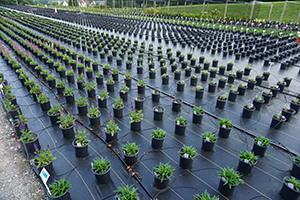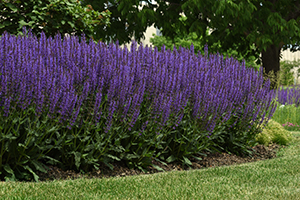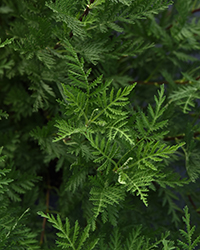Each year, Darwin Perennials seeks to add a range of compelling new varieties to our assortment. As the Global Product Development Manager for Darwin Perennials, the essence of my job is to shepherd varieties from breeding through new product development and make sure the best ones make it to market as introductions.

So, what does it take to bring standout new perennials to the market each year? Let’s explore some key aspects of this journey through a series of interviews featuring some of the behind-the-scenes team members that each plays a vital role in the process. To be able to note the differences that come with working in an established, and perhaps even overcrowded, genus versus a newer one, we’ll follow the path for both Salvia ‘Blue by You’ and Artemisia SunFern™ Olympia.
Breeding
The first step in bringing any new plant to market is the creation of that plant. In most cases that means our passionate breeders begin to research, make crosses, sow seeds, and then search the seedling population for the characteristics they were targeting.

Salvia ‘Blue by You’
Salvia nemorosa has been an industry staple for quite some time, evidenced by the long-loved industry standard Salvia May Night. Introduced several years ago, Salvia ‘Blue by You’ is currently gaining traction in the market with its earliness to flower and its incredible landscape performance. This variety is the result of a joint breeding effort by Michele Scheiber and Jessica Janes.
How did you approach your initial breeding efforts for Salvia that led to this variety?
Michele & Jessica: Our initial approach was to focus on developing hardy Salvia lines with more dramatic flowers, that would be an improvement to compete in the market with May Night. We used traditional S. nemorosa cultivars, and crossed them with the larger meadow flower, S. pratensis. This led to progeny with good hybrid vigor, larger and more floriferous flowers, and ultimately the selection and introduction of ‘Blue by You’.
How long did it take to find the attributes you were targeting with Salvia ‘Blue by You’?
Michele & Jessica: From beginning to end, it took three years to develop ‘Blue by You’ from concept to finished plant. We started the breeding program in 2009, and the initial cross that resulted in ‘Blue by You’ took place in March 2011. Hybrid seed was germinated in tissue culture, transferred to soil, and 31 plants were planted in the field Spring 2012.?’Blue by You’ was selected from that progeny in the field in July 2012 and then it moved on to the trialing process.

Artemisia SunFern Olympia
Artemisia gmelinii is a new-to-the-market species within a familiar genus for Darwin Perennials bred by Christa Kievit. Artemisia SunFern Olympia provides an exciting foliage texture for full sun gardens that is reminiscent of the soft texture of ferns typically reserved only for shady garden locations.
How do you typically go about starting a breeding project for a new-to-the-market species compared to breeding in an established species?
Christa: When starting a new species, I like to think of myself as a detective of sorts. First I’m investigative: I try to collect as much germplasm as I can find to better-understand this new subject. I dig into its details to figure out how to germinate the seed, establish the seedlings, and then determine the best way to continue pollination. Only when I’m satisfied I know the plant inside and out do I finally begin selecting seedling populations for any interesting features. There have been some new species that don’t make it past this phase!
What were the selection criteria you used to screen through the seedling population, eventually leading to the successful introduction of the Artemisia SunFern varieties?
Christa: In a new species you don’t have well defined specs to begin with. We were looking at Artemisia for its foliage, and so we first selected any seedlings with foliage we considered attractive.?The next big selection criteria was to select for well-behaved habits and away from any invasive, aggressive ones. Darwin has a very creative team that is very open to the “unknown” and together we developed the specs for this species.
Trialing
Sara Mellard and Mary Woolman are both heavily responsible for trialing the new varieties that we receive from breeders at our two main trial sites in West Chicago, IL and West Grove, PA respectively.?
When setting out to trial a variety in a crowded category like Salvia, what is important to keep in mind??
Sara: When trialing in a crowded category, the bar is already set, and we need our product to offer some improvement or have a key differentiator than the existing varieties on the market. We need to know how it performs against our current varieties, where it could fit within an existing series, and how it stacks up against the competition. For an established category, we like to bring in as many competing varieties as we can to find out how our potential introduction performs relative to what’s already on the market.
Mary: Exactly! Trialing in a crowded category like Salvia requires the evaluator to pay close attention to the differences between each variety. Details such as bloom time, flower size and habit can really differentiate between varieties. One goal can be to improve an old variety by fixing a problem that has been an obstacle to growers. Another goal can be to cover a different market for Salvia that has not been covered before.
Alternatively, how do you approach trialing in a new category differently than an established one?
Sara: New categories are a different (and fun!) part of working with perennials. We must determine for the first time a lot of things that have been previously defined in more well-established categories. What is the flowering potential and flowering window for this plant? What is the overall habit and size? How will we produce this plant (and CAN we produce this plant)? What kind of environmental conditions does it need to thrive? Where will it fit in the market? What new and exciting attributes does it offer and/or what problem will it solve for growers? And of course, how will the end consumer use this plant in their gardens?
What made Salvia ‘Blue by You’ stand out in trials compared to the other Salvia varieties already on the market??
Mary: Salvia ‘Blue by You’ has been incredibly strong in landscape performance in our in-ground trials in West Grove, PA. It has a habit that really holds together without lodging open like many of the other market varieties. This plant is uniform and reliable in the container leading up to an amazing show in the ground!
Sara: Yes, ‘Blue by You’ is a rockstar! It’s one of my very favorite Darwin Perennials varieties. I have watched it in our Salvia comparison bed in the West Chicago gardens for several years and it’s always first to bulk, comes into bloom at least a week to 10 days earlier than April Night, and re-flushes much quicker after a cutback than competing varieties. Additionally, when it is in bloom, it stands out from a mile away – a solid carpet of blue/purple that is covered in bees and other pollinators.
What was compelling about Artemisia SunFern Olympia that made you feel like this would be a good variety to add to the Darwin assortment?
Sara: Foliage is hot right now and everyone loves the feathery soft texture of ferns, but they generally require a shady location and generous watering, making them unsuited for many sites. SunFern Olympia offers that soft ferny texture but performs great in full sun in our trials and is very drought tolerant. It stays tidier than a lot of other Artemisia I have seen and offers something new to the market with its billowy habit and uniquely dissected foliage.
Mary: I was very pleased to see this as a foliar interest added to the Darwin Perennials assortment. Flowers are wonderful, but the fern-like leaves add texture and valuable divisions between colors in designs.
The future looks bright for Darwin Perennials breeding…
Darwin Perennials is thankful for our talented team who all share a passion for great plants and who each bring their strengths to the table in the pursuit of bringing the best perennials to the market. We are also thankful for our amazing customers and myriad industry relationships who help provide a constant feedback loop on what is working and arguably more importantly what is not.
We love the challenge of solving a particular pain point and bringing a solution to market. All this teamwork and collaboration is leading to some exciting breeding projects that will reinvigorate existing product classes, bring grower solutions, add high impact retail appeal, and/or introduce the market to something all around novel — it’s an exciting time in the world of perennials. The hardest part of my job is definitely keeping all these exciting developments a secret until it is officially their time to shine!
Meet the authors!

Michele Scheiber
• Years as a breeder? I have 18+ years of experience as a breeder. I've bred in a variety of classes including woodies (where I got my start), roses and perennials. I got my start in woodies breeding Abelia at University of Georgia, and we are still breeding Abelia to this day at Star Roses and Plants. Though trained as a classical breeder, I have extensive experience applying cell biology techniques like embryo rescue to accelerate our breeding programs.
• Favorite perennial you bred? Salvia ‘Blue by You’
• Favorite thing about breeding plants? You get to be creative and produce something that didn’t exist previously.

Jessica Janes
• Years as a breeder? I’ve been a breeder at SRP for ~10 years. I started in 2008 but took a three-year hiatus to work retail sales at a high-end independent garden center.?That experience provided me invaluable insight into the needs of our end customers. In 2015, I returned to Star Roses and Plants to pursue my true passion, plant breeding.
• Favorite perennial you bred? Caryopteris ‘Gold Crest’ (so far!)
• Favorite thing about breeding plants? My favorite part about being a plant breeder is getting to be creative with plants. The whole process from concept to development is fascinating, and you never know exactly what will happen along the way. It is very exciting to create and evaluate new hybrids, and to see how each genus improves over time through careful screening and selection. I’m also a plant geek at heart, and I love spending time with my plants in the greenhouse. Pollinating plants is my favorite “day-to-day” activity.

Christa Kievit
• Years as a breeder? Last year marked my 35th anniversary breeding for Ball Horticultural Company!
• Favorite perennial you bred? From seed it’s the Winky Aquilegia and from vegetative it’s the Marvel Salvia. I think these were both important introductions, both in well known classes but different from other varieties on the market. I try to add distinctive qualities to my breeding like the upward facing flowers in the columbines and the large flower size in the Marvels.
• Favorite thing about breeding plants? My Swiss grandparents had a big garden, growing their own vegetables, berries, arranging bouquets every Friday. We would go to the woods and always came home with something, mushrooms, berries, etc. I definitely got my love for nature/plants from them.?The moment I learned that there was a profession called plant breeding I knew what I wanted. Now is an exciting time of the year, seeds do (or don’t) germinate and it is always a surprise what these seedlings bring to you, if the crosses you made result in what you hoped to achieve, if nature has an unexpected gift for you. How are last year’s selections performing during their first season as a clone? It is always a season of expectations, surprises, and it never gets dull.

Sara Mellard
• Years in new product development? I have worked in the horticulture field for around 12 years and New Product Development for almost 4 years.
• Favorite perennial you’ve seen through the trialing process? I love a perennial that looks good both with and without flowers, so our new Polemonium ‘Golden Feathers’ was one of my favorite plants I’ve trialed. I also have a soft spot for vibrant foliage that brightens up the shade, so ‘Golden Feathers’ checks all the boxes for me.
• Favorite thing about trialing plants? Evaluating new genera or completely novel varieties is, for me, the most exciting part of what we do. When I used to work in a garden center it was thrilling to roll those racks full of new products off the trucks in early spring and watch our customers go crazy. Knowing I am part of that selection process now feels like being on the cutting edge of the evolution of the industry, where all the magic happens.

Mary Woolman
• Years in new product development? I have worked in New Product Development for 5 years.
• Favorite perennial you’ve seen through the trialing process? Caryopteris ‘Gold Crest’ is a favorite of mine because it has a unique bloom time in the fall and beautiful blue flower color. It is the first plant with yellow foliage to truly impress me in the landscape.
• Favorite thing about trialing plants? I love making selections the most because it is the first step in recognizing a new variety which is very much like finding the diamond in the rough.

Sarah Greenwood
• Years in new product development? I have worked in New Product Development for 11 years and it never gets old. I love the familiar annual cycle along with the everchanging plant selections both in breeding and trialing. There is comfort in the reliable process and excitement in the newest plants; it’s truly the best of both worlds! I also love how the type of work changes throughout the year with the sunny, hectic summer trial season perfectly balanced with the deep dive planning of the winter months.
• Favorite perennial you’ve seen through the trialing process? This is an impossibly difficult question, as I have so many favorites and they seem to shift depending on the day I’m asked. So, for today I’m going to stretch the question a bit and go with two that have been outstanding in our landscape trials and look incredibly good paired together: Caryopteris ‘Gold Crest’ and Dianthus Mountain Frost™ Red Garnet. I love Fall bloomers like ‘Gold Crest’ that can carry their own throughout the other seasons. ‘Gold Crest’ is a great pollinator plant that literally buzzes in bloom and it hits just the right hue of golden foliage for me as I’m admittedly quite picky about yellow foliage plants. Then there is Mountain Frost Red Garnet with its excellent low mounded habit that is reminiscent of a perfect circle garden steppingstone that is covered with absolutely gorgeous red blooms in the Spring. These two paired together make quite the jewel toned statement!
• Favorite thing about trialing plants? I love the treasure hunt — walking a sea of progeny in search of the best varieties to bring to trial, and then walking the smaller, more carefully curated trials in search of the next new product. I also love the industry relationships, talking about new plants, hearing problem areas, and bringing those problems back to our breeding teams to see if we can solve them. Great people and great plants make this job a rewarding one.